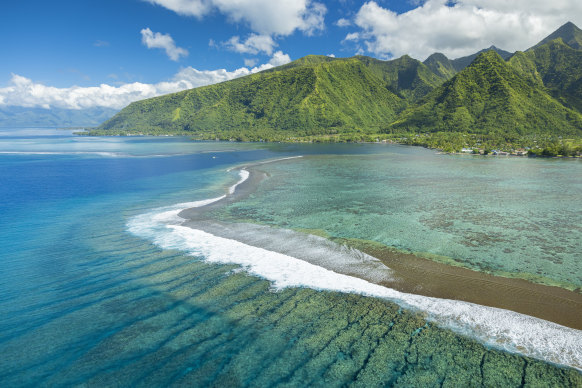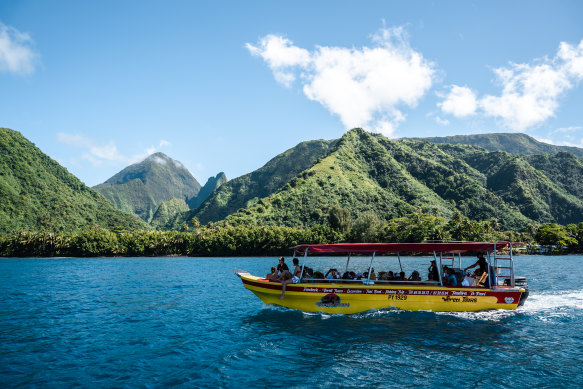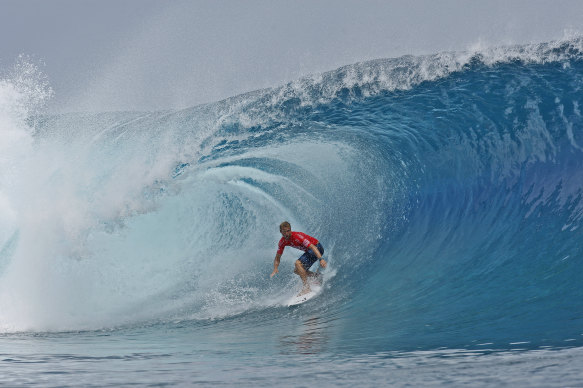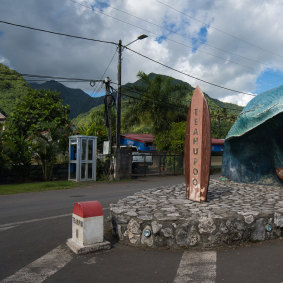This year’s most beautiful Olympic venue is 15,000 kilometres from Paris
Tahiti is one of the planet’s most romanticised destinations. However, modern-day Tahiti has its fair share of detractions: peak-hour traffic jams, a capital city with slums, and few public beaches to access along the strip of coastline hosting most of its resorts.

Tahiti Iti has all the pristine wilderness appeal of French Polynesia’s outer islands.
But the good news is that there are actually two Tahitis. And the other Tahiti – well, that’s the Tahiti you came for, even though there’s hardly anyone to share it with, despite the fact it begins barely an hour’s drive from the airport. And while it’s technically a different island, Tahiti Iti (small Tahiti) is connected by a land bridge, so you don’t need a boat or plane to get there.

A step back in time: Tahiti Iti, connected by boat or bridge.
Once you cross that bridge, you’re in a different world. Green mountains tower above, fishermen sell fresh-caught fish they hang off rope by the roadside, and there’s hardly a car to be seen: because there’s nowhere to go. The road comes to a dead-end half-way down each coastline. Tahiti slows right down in Tahiti Iti to a pace some would say all Polynesia ought to run at.
There are three roads you can choose to take on Tahiti Iti. Drive the north road beside the lagoon until you reach the end at a black sand bay in the picture-perfect village of Tautira. Or take the middle road through pastures to a plateau with views out across Tahiti. But I like the south road best, for it leads to Fenua Aihere (the bush country) – one of the few wildernesses in all of French Polynesia accessible only by boat or foot.
Take the south road beside the sea until it ends at the tiny fishing village of Teahupoo. You might recognise the name – it’s where the world’s best surfers gather for two weeks each year to surf the planet’s most dangerous wave. Death-defying images are broadcast across the globe for a fortnight and then Tahiti Iti becomes a secret all over again. This year, however, Teahupoo has gone one step beyond – serving as the surfing site for the Paris Olympics.

Tahiti Iti is where you’ll find the planet’s deadliest wave: Teahupoo.
The best way to explore the bush country of Tahiti Iti is on a full-day boat tour beyond Teahupoo. There are hiking trails across the wilderness. If you’re fit and have a guide, you can traverse the entire 22-kilometre roller-coaster track from east to west. But travelling by boat allows me to appreciate the scale of the wilderness from the lagoon. And saves me a lot of sweat.
Gigantic triangular mountains – their tips covered in cloud – drop down at right angles, creating huge shadowy, hidden valleys. Humpback whales congregate in the waters beyond the reef to give birth in winter, while pods of bottlenose dolphins surf the bow waves of our boat.
Beyond Teahupoo there are only 30 or so houses out among the wilderness – simple family shacks with no water or electricity. Tahitians lived throughout these hidden valleys before European disease killed 80 per cent of the population in the 19th century. Now only their legends remain, and the mana you still feel lurking in sacred sites. The boat leaves the lagoon and advances into a slow-moving river. We get out and walk along a trail through thick forest into a pitch-black waterhole within a cave, once a place of initiation for boys to become warriors. We walk further through wilderness until we reach cliffs along a coastline, and leap into the water below.

For two weeks a year Teahupoo becomes the most famous wave break on the planet.
The journey feels as much a travel through time as any scenic ride, though back on the parts of Tahiti Iti they managed to build roads to, there’s still little sign of the 21st century. Local dance troupes rehearse in the dusk most evenings; the beat of their log drums makes me feel like joining in. There are far more pigs and chickens here than humans, but the humans I find look content living simpler lives than their countrymen on the “other Tahiti”.
THE DETAILS
FLY
Air Tahiti Nui fly to Tahiti via Auckland five times a week, see au.airtahitinui.com. Hertz, Europcar and Avis offer rental cars at Tahiti’s international airport
STAY
Stay in a quirky treehouse-style villa with views across Tahiti at Vanira Lodge from $293 a night. See vaniralodge.com
TOUR
Take a full-day or half-day boat tour of the wilderness beyond Teahupoo with Teahupoo Tahiti Surfari from $170 a person (tahitisurfari.com/teahupootours); or take a hike through the area with trained guides from $160 (tahitisuntours.com/en/te-pari-hike).
The writer travelled courtesy of Tahiti Tourism.
Sign up for the Traveller Deals newsletter
Get exclusive travel deals delivered straight to your inbox. Sign up now.